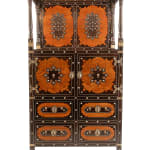Contador de grandes dimensões (Dressoir) Indo-português / Exceptional Cabinet (Dressoir) from Sind, Sindh, actual Paquistão, ca. 1580-1630 / Sindh, nowadays Pakistan, c. 1580-1630
Teca, ébano, marfim, osso, pigmento ( sadeli ), ferro e cobre dourado / teak, ebony, ivory, exotic wood, green-dyed bone and iron, gilt copper fittings
182 x 97 x 61 cm
A600
Further images
-
(View a larger image of thumbnail 1
)

-
(View a larger image of thumbnail 2
)

-
(View a larger image of thumbnail 3
)

-
(View a larger image of thumbnail 4
)

-
(View a larger image of thumbnail 5
)

-
(View a larger image of thumbnail 6
)

-
(View a larger image of thumbnail 7
)

-
(View a larger image of thumbnail 8
)

-
(View a larger image of thumbnail 9
)

-
(View a larger image of thumbnail 10
)

-
(View a larger image of thumbnail 11
)

-
(View a larger image of thumbnail 12
)

-
(View a larger image of thumbnail 13
)

-
(View a larger image of thumbnail 14
)

-
(View a larger image of thumbnail 15
)

This cabinet, made from teak (Tectona grandis), is thickly veneered in ebony (Diospyros ebenum) and lavishly decorated with ivory inlays and micro-mosaic (sadeli). The piece is structured into three sections, with the two lower portions seamlessly joined, and a detachable, open baldachin-shaped upper section. The upper section features four turned columns resting on gilt copper collets, elegantly crowning the uprights on the corners of the middle and lower sections. This heavy, sturdy cabinet rests on four solid ebony feet carved in the shape of a crouched dragon, with eyes inlaid in ivory and decorated with gilt copper dome-shaped studs. Throughout the piece, hemispherical studs are strategically employed to highlight its surfaces complementing the cabinet’s gilt copper fittings, which include corner brackets, side handles, hinges, escutcheon-shaped pierced openwork lock plates, and drawer pulls. The upper section was used to showcase display silver as a dresser (from the French dressoir) or as a buffet — a sideboard to display cups and dishes featuring a high back or an overhanging canopy. The two-door middle section was intended for the secure storage of valuables and documents, while the lower section served to store fine table linens and other precious textiles.The lower section is a chest fitted with two large drawers, mimicking four, decorated on the fronts with oblong Timuridstyle cartouches featuring ebony borders highlighted with ivory fillets. The middle section is fitted with two doors, each decorated with Timurid-style star-shaped polylobed ebony medallions on particularly beautiful figured or curly grain of teak wood, similarly highlighted with thin ivory fillets. The doors open to reveal twelve drawers, mimicking sixteen arranged in four tiers. The fronts of the drawers are richly decorated with oval-shaped medallions in sadeli, bordered by a frieze of contrasting triangles in exotic wood and ivory. The interior sides of the doors follow a carpet-like arrangement boasting a central field with a large circular medallion and an Islamic-type eight-pointed star featuring a complex star pattern of finely-made sadeli.This large micro-mosaic star contrasts with the dark ebony ground, decorated with vegetal scrolls of coma-shaped leaves. The corners of the central field are similarly decorated with vegetal scrolls and star-like sadeli motifs. The central field is bordered by a narrow frieze of triangles in alternating colours and a wide border of vegetal scrolls dotted with small sadeli circles. The square overhanging canopy or baldachin-shaped upper section comprises: four turned ebony columns on the corners; a rear board decorated on the front with two facing large oval-shaped polylobate Timuridstyle cartouches in ebony over the teak ground highlighted in ivory; and the multi-arched cornice on top in ebony similarly accentuated with ivory fillets and large gilt copper studs. While the back is in plain, undecorated teak of fine quality, the sides are decorated en suite with the middle and lower sections, boasting elegant Timurid-style cartouches.Following a European prototype, this large cabinet was made for a wealthy aristocratic household, reminiscent of contemporary opulent ebony, marquetry or pietre dure (hardstones) cabinets made at the most affluent courts of Europe. Bridging Western furniture types with local, highly elaborate decorative techniques and costly exotic materials, this cabinet epitomises the refined taste of the Portuguese clientele that commissioned it. Based on furniture types, preferred materials, and Iranian-derived decorative techniques such as the time-consuming sadeli, this elegant and sombre production, when compared with furniture made for export in Gujarat, has recently been attributed to Thatta in Sind (present-day Pakistan). Examples of such large pieces of furniture made for export in the western coastal centres of India are exceptionally rare. A decade ago, a single identical and similarly decorated cabinet (dim.: 181.0 × 90.0 × 64.0 cm) was published, differing solely in the decoration of the inner drawers and the later sledge-form feet.The present cabinet, a magnificent example of export furniture made in India under Portuguese patronage, adorned until recently the Casa do Costeado in São Miguel de Creixomil, Guimarães — a manor house in the north of Portugal built in the late eighteenth century on an estate documented since the late sixteenth century.
Provenance
Casa do Costeado, Guimarães;J.A.F., Moreira de Cónegos.
10
of
10
Join our mailing list
* denotes required fields
We will process the personal data you have supplied in accordance with our privacy policy (available on request). You can unsubscribe or change your preferences at any time by clicking the link in our emails.














